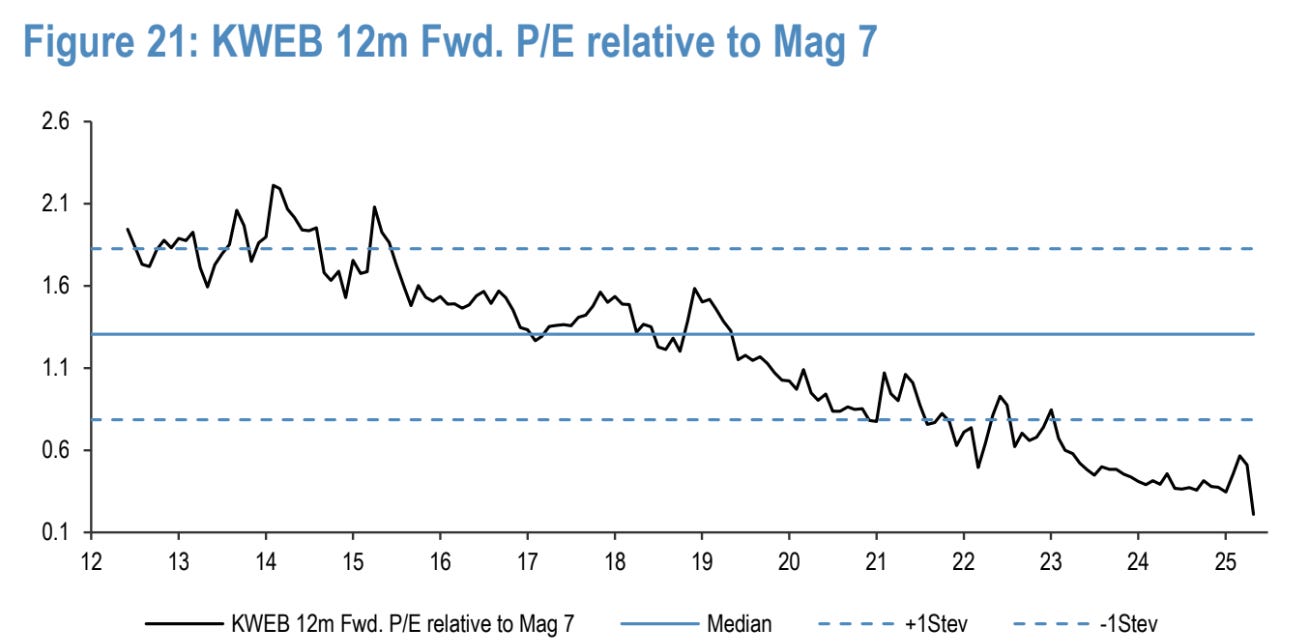I haven't owned a meaningful position in U.S. stocks for two years. While everyone else chased the AI boom, I've been buying Chinese tech giants at single-digit multiples and forgotten compounders trading at reasonable prices.
This contrarian bet has already paid off—my portfolio delivered solid returns despite missing the U.S. rally entirely.
But I think the real payoff is just getting started.
The math is simple: when you're paying $36 for every dollar of free cash flow in the S&P 500, but can get the same dollar for $12 in emerging markets, the choice becomes obvious. At least, it should be.
Yet here we are in 2025, with U.S. stocks trading at their most expensive levels in decades while the rest of the world sits on clearance.
The Most Expensive Party in History
Let's start with the uncomfortable truth. U.S. equities are expensive. Not "a little pricey" expensive—historically, dangerously expensive.
The S&P 500 trades at 22.3x forward earnings as of late May 2025, well above its 20-year average of 16.7x. That puts the index roughly 50% above normal valuations.
The few times we've been this stretched (e.g., 1999 and briefly during the pandemic euphoria) haven't exactly been followed by stellar returns.
But it's not just the multiple that worries me. It's the concentration. The top 10 stocks now represent nearly 40% of the S&P 500's market cap. That's the highest concentration we've seen in over a century.
Seven companies control more than one-third of the index's performance. This level of concentration extends far beyond index investing—it permeates the entire U.S. equity market, where these same mega-cap names dominate every conversation and most portfolios.
The free cash flow yield tells the same story.
The S&P 500's free cash flow yield has collapsed to just 2.74%—the lowest level in two decades.
Level up your investment research with Koyfin's powerful market analytics platform. Try Koyfin today using my referral link and get 20% OFF any paid plan!
Try Koyfin Now!
You're paying $36 for every dollar of free cash flow generated. Compare that to emerging markets, where you can get the same dollar of cash flow for roughly $12.
This isn't about being anti-American or pessimistic about innovation. It's about math. When the broad U.S. market trades at these levels, you're betting that either earnings will grow dramatically faster than historical norms, or you're comfortable with below-average returns for the next decade.
History suggests neither is particularly likely.
I just can't get excited about paying these prices when there are so many better opportunities elsewhere.
Where the Real Opportunity Lives
While American investors obsess over the same seven mega-cap names, the rest of the world is on sale.
Emerging markets trade at just 12.7x forward P/E versus 22.3x for U.S. stocks. That's roughly half the valuation for companies projected to grow earnings significantly faster over the next three to five years.
The discount is even starker on a price-to-book basis, where emerging markets trade at a 40% discount to developed markets. But nowhere is the disconnect more obvious than in China.
Chinese equities are trading at their deepest discount to global markets in over a decade. MSCI China is now trading at just 0.6x the valuation of MSCI World on a forward P/E basis. That's about one standard deviation below the historical average.
Think about what that means. You're getting Chinese companies—many of which are global leaders in their industries—at half the multiple of the rest of the world.
The same companies that dominated e-commerce, gaming, and digital payments globally are now priced as if they're about to disappear.
It gets even more extreme when you look at how cheap Chinese tech has become relative to U.S. tech. The KWEB ETF, which tracks Chinese internet companies, is trading at just 0.3x the forward P/E of the Magnificent Seven. That's the lowest relative valuation we've ever seen.
We're talking about companies generating massive free cash flows, sitting on fortress balance sheets, and operating in the world's second-largest economy. Yet they're priced as if they're penny stocks.
The regulatory overhang that kept these valuations depressed is finally lifting, with Beijing signaling a much more supportive stance toward the tech sector.
I've been adding to Chinese positions steadily over the past two years. While most investors chased AI hype at 40x sales, I was buying category-leading businesses that actually generate billions in free cash flow at single-digit multiples.
The irony is thick.
Everyone's paying premium prices for American tech stocks they've owned for years, while equally compelling businesses trade at a fraction of the price.
Where I'm Actually Putting My Money
Let me be specific about where I'm putting my money, because generic market commentary is worthless without skin in the game.
Keep reading with a 7-day free trial
Subscribe to Coughlin Capital to keep reading this post and get 7 days of free access to the full post archives.









